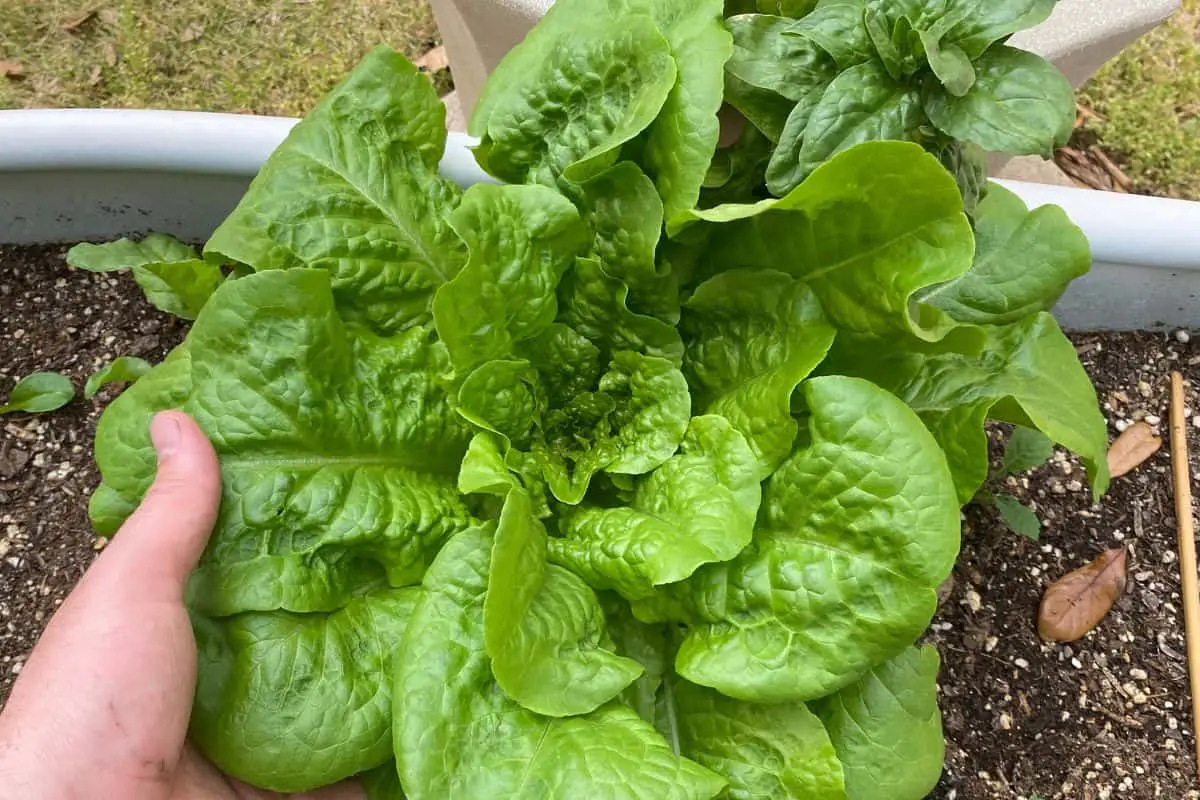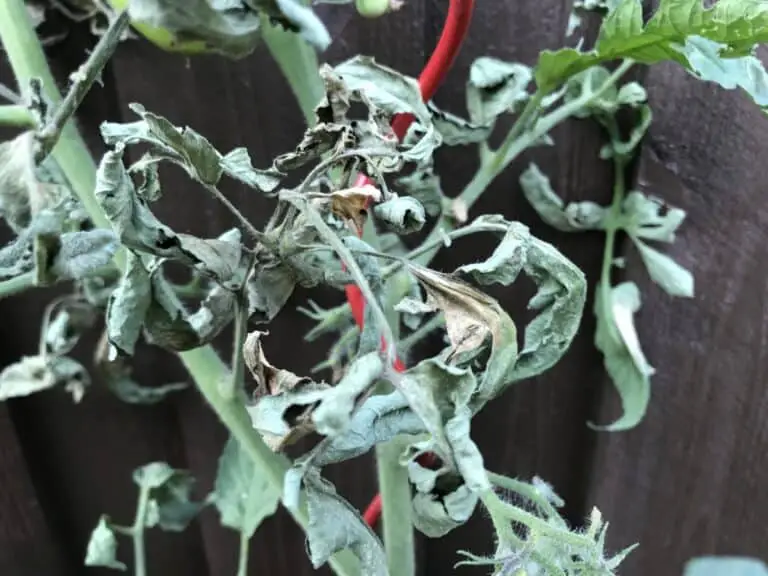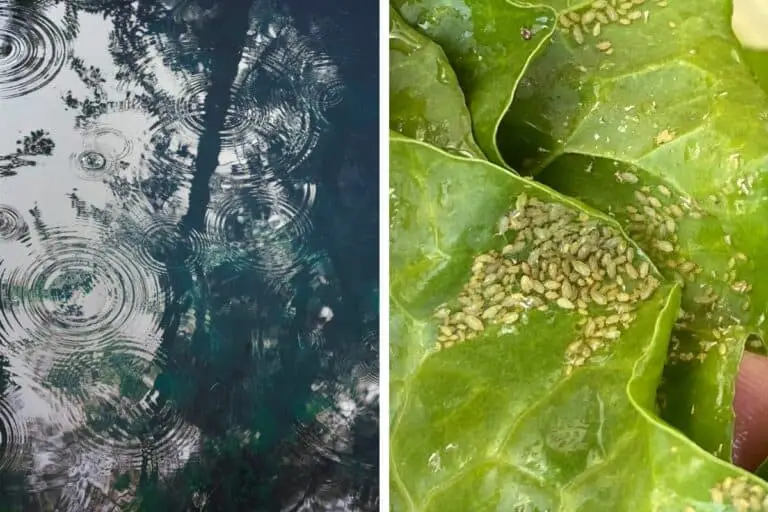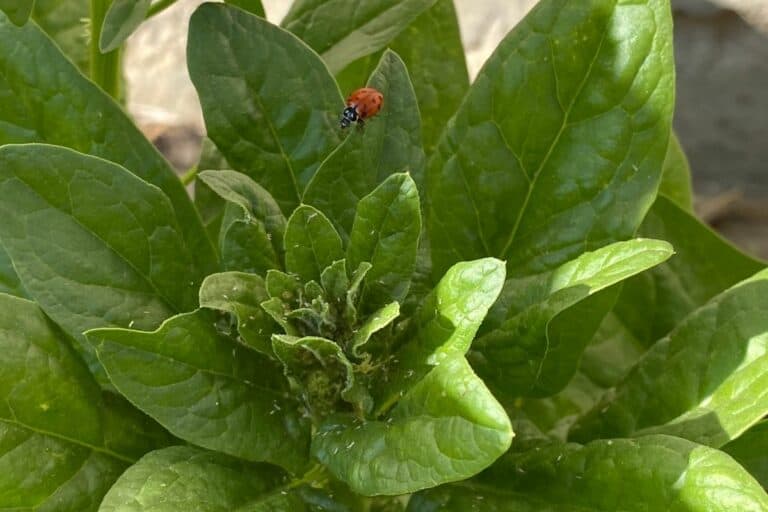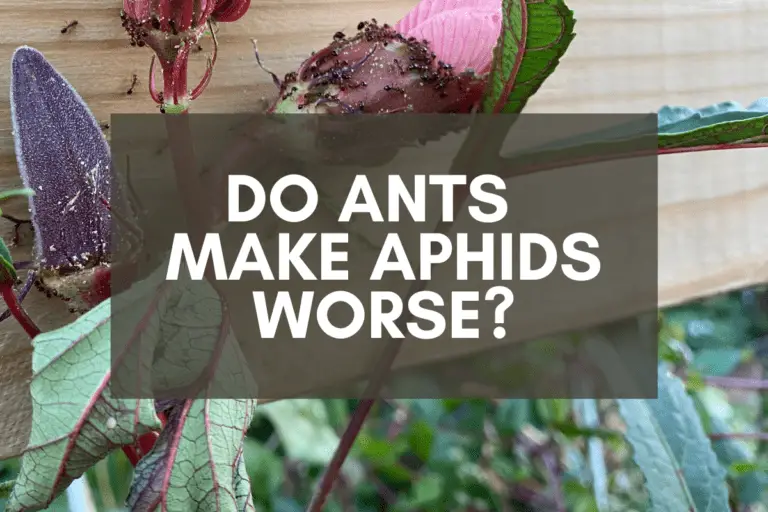Get Rid of Ants on Your Lettuce in 4 Easy Ways
One of my favorite things to grow is lettuce. I go overboard in the spring planting rows of butterhead, loose-leaf, and romaine (my neighbors love me!). And I can often get a great fall crop since I live in Zone 8, which has a longer growing season.
But whether it’s spring or fall, one of my least favorite things is seeing ants on my lettuce plants.
A couple of ants crawling around my lettuce: no big deal. But hundreds teeming over the leaves? That just ratchets up my gardening anxiety.
I hope you’ve never had this experience. But if you’re reading this article, you probably have. Fortunately, there’s an easy, DIY solution that will take care of your ant-infested lettuce problems.
The best way to get rid of ants on lettuce plants is to take care of the underlying problem: aphids. Mix 5 tablespoons of liquid soap per gallon of water, then spray plants thoroughly, especially the undersides of leaves. Once the aphids are gone, the ants will leave the plants in search of food.
You might think that 5 tablespoons seems like a lot of soap, but there’s a method behind my recipe, so read below to see why, how, and when I spray my lettuce plants with a powerful soapy water spray.
In this article, I’ll help you take care of your ants problems by:
- explaining why ants are on your lettuce.
- giving you 3 natural solutions with 3 easy steps each to eliminate them.
- providing you with fact-based information for greater peace of mind.
- equipping you with ways to prep and maintain your garden to handle infestations whenever they arise.
By the end of this article, you’ll be able to get rid of both ants and aphids on your lettuce plants like a champ!
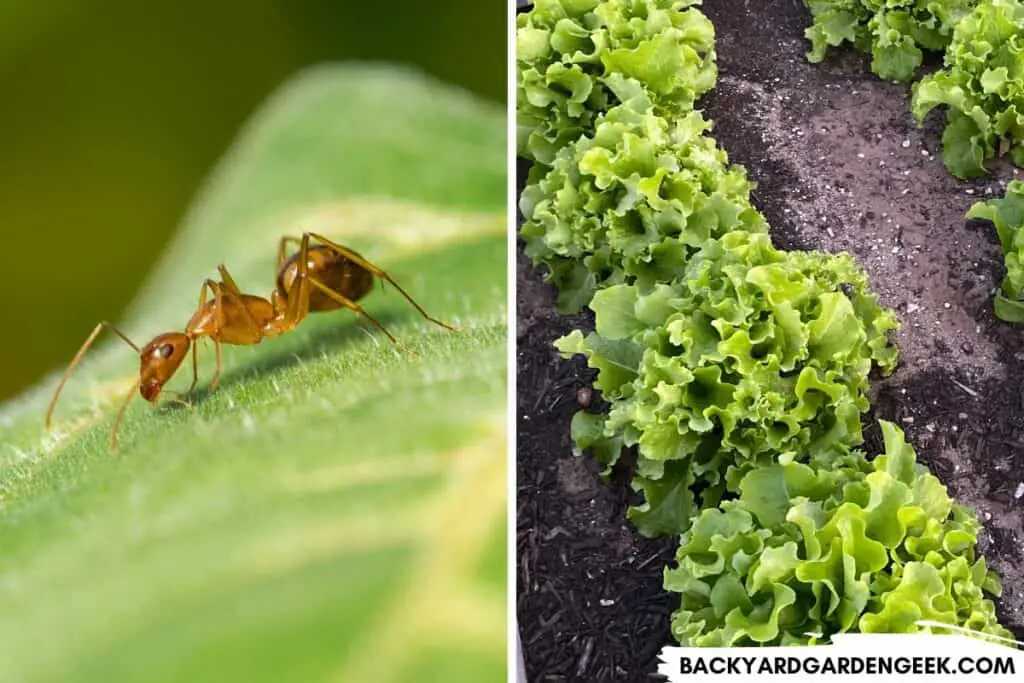
Why Are Ants on My Lettuce?
Ants are both beneficial and detrimental to your garden. On the plus side, they do the following:
- accelerate the decomposition process of plants and insects.
- aerate the soil, which makes it easier for water, oxygen, and nutrients to get to plant roots.
- aid with seed dispersal through their foraging activities.
- contribute to plant pollination.
- help with pest control.
When I started gardening, I didn’t know all that. I thought ants in the garden were bad, plain and simple.
I now realize that ants are not only part of a healthy garden ecosystem. They’re also a helpful early-warning signal!
Simply put, when I notice a significant surge in ant activity, I know right away that they’re alerting me to the presence of aphids among my plants.
Ants on lettuce plants are a sure sign of aphids since ants and aphids are symbiotically linked. Aphids produce sugary honeydew droplets as they feed on plant nutrients, and ants protect aphids from predators in order to harvest as much honeydew as possible to carry back to their colony.
By day, the ants herd the aphids like cows around the lettuce plants and guard them against predators while they feed on plant sap. The honeydew they secrete is an ant delicacy and is the raison d’etre for the aphid-ant relationship.
With the exception of leafcutter ants, ants won’t eat or damage your spinach plants. However, aphids will, and since ants protect aphids against various aphid-eating bugs, you’ve got to do something about both aphids and ants or your lettuce won’t thrive.
The aphid-ant relationship hurts lettuce in several ways:
- Excessive sap feeding stunts growth and reduces harvest.
- Large aphid infestations cause the lettuce leaves to wilt and turn yellow.
- Lettuce root aphids (Pemphigus bursarius) can even live among and attack lettuce roots.
- Aphids can suck nutrients from lettuce plants and then kill them off entirely.
For those who might be interested, there are 4 ways that lettuce root aphids differ from other aphids:
- Lettuce aphids have shorter antennae, less than 1/3 of their body length.
- They have smaller cornicles (tail pipes sticking out from the back of the abdomen).
- Adult winged and wingless lettuce root aphids have black markings on the joints of their legs and antennae (and some have black markings on their abdomens).
- They overwinter in the egg stage on the bark of Lombardy poplar trees and migrate from there to your lettuce plants.
I’ve never had to deal with lettuce root aphids, but I’ve seen plenty of other aphids in my garden.

Unfortunately, there are nearly 5,000 aphid species spread across the world, and they come in all kinds of colors and sizes, including black, green, red, white, and yellow. They’ll arrive from just about anywhere, invade your garden, spread from plant to plant, and make it through the cold winter months so as to attack your plants again the following year.
As you can see if you view the links above, I’ve written lots about aphids because I’ve spent years getting rid of them once they arrive in my garden.
Here’s the good news: Aphids prefer cabbage, potato, spinach, roses, sunflowers, and tomato plants (and even some weeds) over lettuce plants. Consequently, you’ll only see aphids on lettuce plants if there’s nothing else readily available for them to eat.
But here’s the bad news: Lettuce is a cool-season crop planted in early spring or mid fall, and this is often the exact time when aphids’ preferred food sources aren’t available.
This is why you’ve got to keep an eye out for the ants. They’re your early-warning friends!
Pro Tip: Aphids love quite a few plants, but they don’t seem to like garlic and marigolds. So as soon as it’s warm enough, plant marigolds near your lettuce. And since garlic is usually planted in the fall and harvested from late spring to mid-summer, plant your lettuce where you know your garlic will emerge.
That way, you’ll have some companion plants that’ll help your lettuce thrive as it grows.
Take a glance at these articles if you’d like to learn more about how aphids can negatively impact your garden this year:
- Are Aphids Good or Bad? Everything You Need to Know
- Can You See Aphids on Plants? Spotting Early Infestations
- Can Plants Recover from Aphids? Tips to Save Your Plants
- Are Aphids Poisonous?

How Do I Safely Get Rid of Ants on My Lettuce? 4 Simple Ways
Over time, I’ve tested many methods to rid my garden of the pesky ant-aphid twosome. Some worked. Others didn’t.
One recommended method is blasting them off with a strong stream of water from the garden hose. This’ll works okay for plants with stronger stems and leaves (e.g. pepper, tomato, cabbage, and broccoli plants) though not so well on the tender leaves and heads of lettuce plants.
Unless you want to ruin your harvest, don’t spray your lettuce plants with strong jets of water. Instead, I recommend these three soft-spray recipes to dislodge the ant-aphid duo.
Each has three steps, and these treatments are all highly effective, natural, and environmentally friendly.
1. Vinegar, Liquid Dish Soap, and Water
This is my go-to natural solution for controlling ants and aphids on lettuce. Because this solution is very cost-effective, you can use this in larger garden plots by attaching it to a pump pressure sprayer.
Here are the steps to follow:
- Take 1 gallon of water (3.8 L) and pour in 1 cup (1/4 L) of distilled white vinegar.
- Add 1 teaspoon (5 ml) of liquid dish soap and mix well.
- Transfer to a spray bottle and douse all parts of your lettuce plants.
2. Baking Soda, Vegetable Oil, and Water
This is another easy solution from ingredients you already have in your kitchen. Any vegetable oil will do; however, make sure it’s additive-free.
Here are the steps:
- Add 1 cup (1/4 L) baking soda to 1 gallon (3.8 L) of warm water.
- Add 1 1/2 teaspoons (7.5 ml) of vegetable oil and mix thoroughly.
- Transfer to a spray bottle and soak your plants.

3. Soapy Water Spray
If you’ve got an extreme aphid infestation, you might need to get much more aggressive with those aphids.
In that case, here’s what I do:
- Fill up a 1- or 2-gallon garden sprayer with water (3.8 to 7.6 L).
- Add 5 tablespoons (75 ml) of liquid castile soap to the container.
- Shake vigorously and apply to plants in the late afternoon or early evening to avoid damaging your lettuce.
4. Banana Peels and Water
In anticipation of aphids in my spring garden, I mix this concoction up a week before I transplant my lettuce into the garden. Not only does it get rid of aphids, but it’s also a good plant fertilizer.
Here’s what I do:
- Chop the peels of 2-3 bananas into small pieces, place them in a container, cover them with water, and leave them in a cool, dark place for 2 weeks. You can add more banana peels during this time, but don’t change the water.
- After 2 weeks, strain the mixture and mix it with fresh water: 1 part banana mush with 1 part water.
- Transfer to a spray bottle and saturate the entire plant.
Because lettuce aphids feed deep inside your plants–toward the center of loose leaves and at the heart of the plant–make sure you spray all parts of the plants as well as the top of the soil.
Want to learn more about the relationship between ants and aphids? Check out these articles for the details:
- Do Aphids Attract Ants?
- Do Ants Eat or Kill Aphids? 6 Environmental Factors
- Do Ants Make Aphids Worse? 7 Behaviors to Understand
- Why Do Ants Protect Aphids? 7 Things You Should Know
Now that you know how to get rid of ants on your lettuce and take care of any underlying aphid problems, head outside and spray your lettuce!
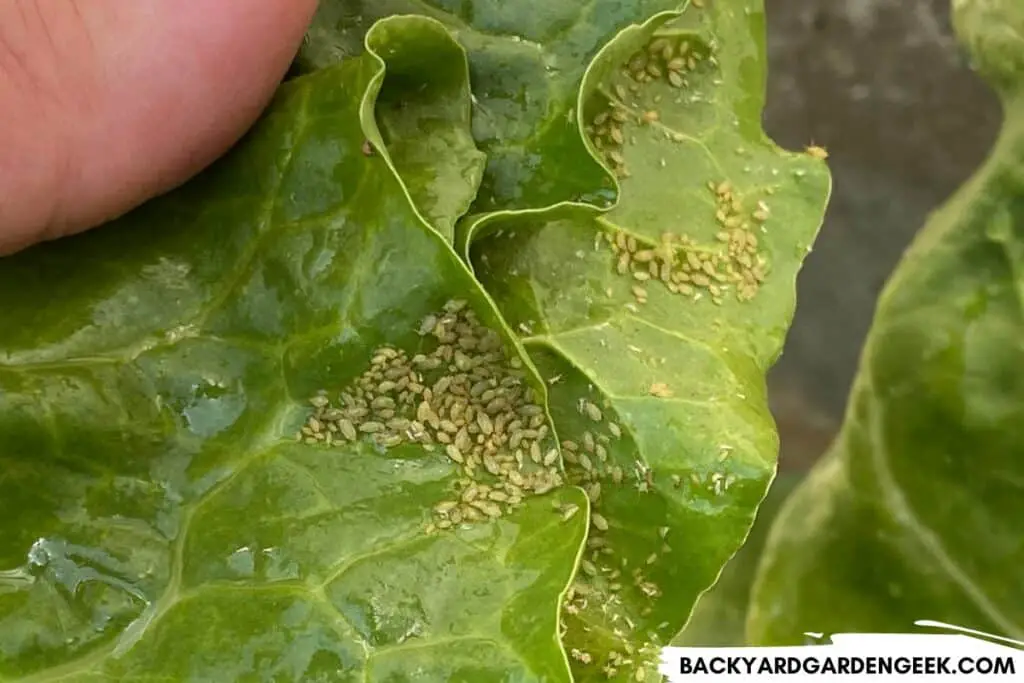
Are Lettuce Aphids Harmful to Humans?
I’ve written extensively about whether aphids are harmful to humans and whether they can injure pets, but here’s the short answer:
Aphids don’t bite or sting and thus can’t harm humans or pets. Unlike ants, ticks, and other insects that bite, aphids can’t puncture human or animal skin because their mouthparts (known as stylets) can only pierce plant tissue.
Although aphids are known to spread diseases to hundreds of plant species, they don’t spread diseases to humans or animals.
And when it comes to ingesting them, I know it’s yucky to think about, but they’re perfectly safe for human consumption. They’re soft-bodied and tiny, and they won’t make you sick.
When it comes to eating lettuce, you’ll want to make sure your delicious veggies are aphid-free. Here are five steps you can take to do so:
- Take a magnifying glass with you when you go to harvest your lettuce. If there are ants on the leaves, look beneath the ants. If there are lots of aphids present, you’ll be able to see them easily without using the magnifying glass.
- Cut off the outermost leaves of your lettuce plants so that the plant can continue to produce more leaves. Inspect the leaves to see if there are aphids on them
- Put your lettuce in an ice bath for 20-30 minutes. It’s hard for lettuce aphids to survive after a prolonged icy immersion.
- Run them through your salad spinner, then pat dry dry to dispel any aphid stragglers.
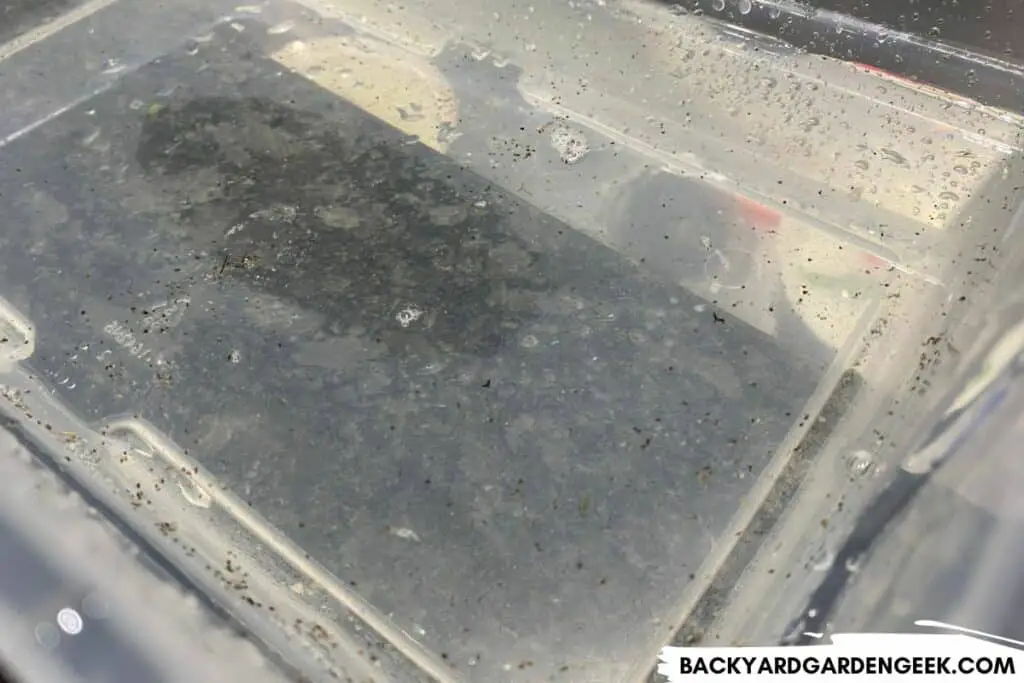
In case you’re interested in doing your best to prevent lettuce aphids in the future, you can do so by:
- maintaining optimum water levels for lettuce to reduce plant stress.
- practicing companion planting instead of planting all of your lettuce in the same general area.
- planting your lettuce as far away as possible from poplars (or remove them altogether from the perimeter of your garden to be on the safe side).
- working the soil deeply and allowing it to dry thoroughly if you had a lettuce root aphid infestation occurred in a previous crop.
Of course, you can’t keep aphids out of your garden since there’s just so many species spread across the world. But you can keep your eyes open, take note of ant movements, and work quickly to stop any emergent aphid infestations.
More Information
If you’d like to read more about ants and aphids, check out these related articles to learn everything I know about how to deal with these garden nuisances:
